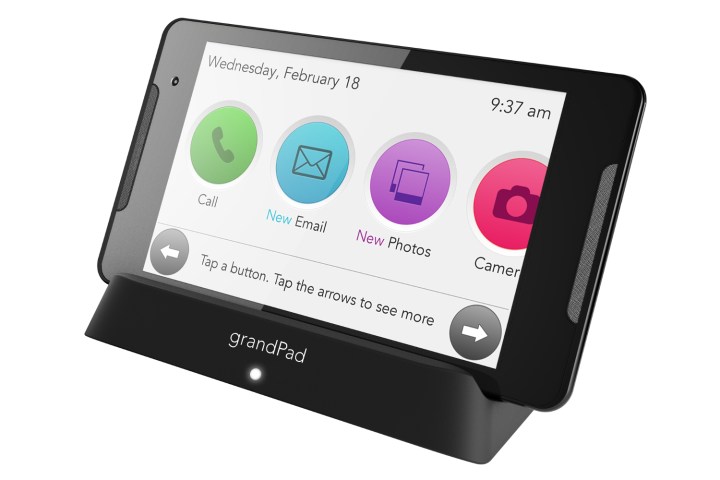
Unfortunately, we don’t have the actual hardware ingredients for the refreshed grandPad device. However, it will be a second-generation model following the original grandPad tablet released in November 2014. That is quite a long time for a hardware refresh, but the device doesn’t focus on performance but rather connecting senior citizens to friends and family.
As a reference, here is a brief list of hardware details regarding the first-generation grandPad tablet:
| Operating system: | Android |
| Screen size: | 7 inches |
| Screen resolution: | 1,920 x 1,200 |
| Processor: | Qualcomm Snapdragon S4 Pro 8064 (quad-core) |
| Processor speed: | 1.5GHz |
| System memory: | 2GB |
| Internal storage: | 32GB |
| Connectivity: | Wireless N 4G LTE |
| Cameras: | Front – 1.2MP Back – 5MP |
The upcoming second-generation model builds on that foundation by expanding the screen to eight inches. The deal with grandPad is that it sports large holding areas on each side for easy handling and the new model provides 10 percent more gripping space. The updated model even incorporates two high-quality front-facing speakers to boot for a better communication experience.
Additionally, the new model upgrades the front camera to 5 megapixels and the overall visual quality with an increased pixel density and brightness. Other highlights consist of an included custom built case, an included dock supporting Qi wireless charging, and new apps for easier reading and using the rear LED as a flashlight.
Unfortunately, grandPad can’t be purchased outright. Instead, customers must select a monthly plan to use the device and its associated services. When customers cancel the plan, the tablet and its accessories must be returned to the company. Customers can choose to pay $75 per month for the device and service, or a hefty $786 annually (which equals out to $65.50 per month).
The grandPad subscription plans include the tablet, senior-friendly stylus, Smart Case, and dock. The plans also cover all applications installed on the device, 4G LTE connectivity to the internet, damage and theft insurance, unlimited on-device “white glove” customer support (U.S.-based), and free personalized music. Customers signing up for the annual plan are not required to pay shipping and handling fees while monthly subscribers must initially pay $29.
The grandPad tablet is based on Android, but the interface is customized for simplicity. With just a touch, senior citizens can make voice and video calls, send/receive emails and messages, access photos and use the camera, play games, and contact support. There is a separate Companion App too for iOS and Android devices enabling family members to share photos, videos, music, and other content to the grandPad tablet.
According to grandPad co-founder Isaac Lien, the first grandPad tablet was an off-the-shelf Android device repurposed with a custom version of Google’s operating system. For the second-generation model, the company teamed up with Acer to build an entirely new device from the ground up for senior citizens aged 75 and over. The technical details of the second-generation unit aren’t finalized, hence the lack of any hardware refresh details.
News of the collaboration arrives after grandPad and Acer announced a strategic partnership in March 2016. Acer made an equity investment in the company, enabling grandPad to tap into Acer’s hardware design capabilities, its resources, and its experience in computing and communication. GrandPad is based out of Orange, California.
Editors' Recommendations
- The OnePlus Pad is a lovely Android tablet with a surprising flaw
- This is OnePlus’ next Android tablet — the OnePlus Pad Go
- Don’t buy the Pixel Tablet; get this cheaper Android tablet instead
- Tablets at CES 2023 are beating the iPad in big and unexpected ways
- How phones, social media, games keep seniors connected, safe


